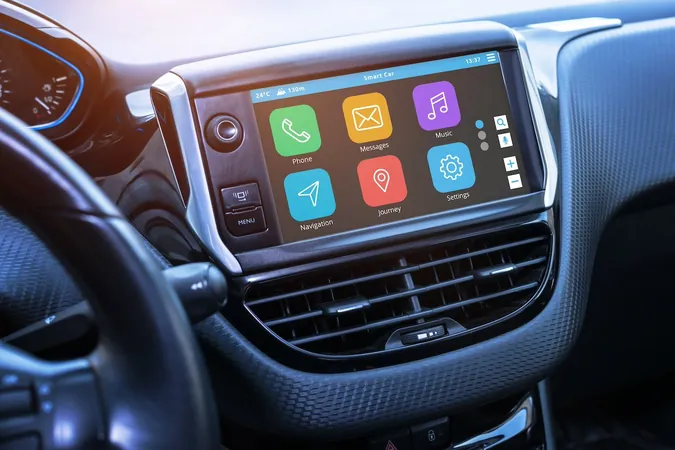
Are Infotainment Screens Becoming Obsolete in Modern Vehicles?
2025-03-29
Author: Michael
Are Infotainment Screens Becoming Obsolete in Modern Vehicles?
In an era where technology dominates the automotive landscape, vehicle infotainment systems have found themselves at a crossroads. While these advanced screens have transformed the way we interact with our cars, public sentiment is shifting, raising questions about their future in the automotive world.
The Rise of Touchscreen Technology
The rise of touchscreen technology can be traced back to the mid-2010s when Tesla introduced its iPad-like controls, which quickly captivated the market. As a result, today, approximately 97% of new cars are equipped with touchscreen displays, with nearly a quarter boasting screens that measure 11 inches or more. But despite this prevalence, many drivers are beginning to voice their dissatisfaction with these digital interfaces.
Usability Challenges and Safety Concerns
Infotainment systems are praised for their sleek design and numerous features. They often allow drivers to access messaging apps, streaming services like Netflix, and an array of car controls, all through a central hub. Yet, the convenience of having everything in one place is overshadowed by usability challenges. Surveys indicate that only 15% of drivers would prefer a full-width display, while less than 20% show interest in windshield-based displays.
Safety concerns are driving the backlash against these tech-heavy systems. Navigating complex menus while driving can be distracting and dangerous. The 2021 recall of Tesla vehicles, triggered by a flash memory issue that disabled rearview cameras and essential functions like defrost, illustrates potential hazards when technology fails. Additionally, legal issues have arisen, such as a recent class-action lawsuit against Stellantis, which claims that defective infotainment screens have led to critical safety failures, including backup camera malfunctions.
Automakers Rethink Their Approach
In response to growing consumer frustration, some automakers are beginning to rethink their approach. Volkswagen, for instance, has pledged to reintroduce physical buttons after facing backlash regarding its new touch screen-heavy models. VW CEO Thomas Schäfer acknowledged that relying heavily on touch interfaces “did a lot of damage” to the brand's image.
Innovative Solutions and Hybrid Models
As the industry grapples with these challenges, some manufacturers are exploring alternative solutions that blend technology with user-friendly design. BMW's latest heads-up display (HUD), introduced at CES 2025, places vital information at the bottom of the windshield, allowing drivers to customize what they see without taking their eyes off the road. This innovative system also integrates physical controls that can be operated through the steering wheel, enhancing safety by keeping the driver’s hands on the wheel and their attention forward.
In addition to HUD advancements, voice-command technology is gaining traction. Mercedes has implemented voice controls powered by ChatGPT, while Apple has introduced voice functionality to CarPlay with iOS 18, allowing users to interact with their infotainment systems without diverting their attention from the road.
The Future of Infotainment Systems
As automakers innovate and strive to address safety and usability concerns, the future of infotainment systems remains uncertain. Will we see a return to physical controls, or will hybrid models emerge that enhance safety without sacrificing technological advancements? The evolution is ongoing, and consumer demands will undoubtedly shape the next generation of automotive infotainment.
With safety at the forefront and technology continuing to advance rapidly, one thing is certain: the journey to find the perfect balance between convenience and safety in vehicle design is far from over. Stay tuned as the automotive industry navigates these shifting tides!









 Brasil (PT)
Brasil (PT)
 Canada (EN)
Canada (EN)
 Chile (ES)
Chile (ES)
 Česko (CS)
Česko (CS)
 대한민국 (KO)
대한민국 (KO)
 España (ES)
España (ES)
 France (FR)
France (FR)
 Hong Kong (EN)
Hong Kong (EN)
 Italia (IT)
Italia (IT)
 日本 (JA)
日本 (JA)
 Magyarország (HU)
Magyarország (HU)
 Norge (NO)
Norge (NO)
 Polska (PL)
Polska (PL)
 Schweiz (DE)
Schweiz (DE)
 Singapore (EN)
Singapore (EN)
 Sverige (SV)
Sverige (SV)
 Suomi (FI)
Suomi (FI)
 Türkiye (TR)
Türkiye (TR)
 الإمارات العربية المتحدة (AR)
الإمارات العربية المتحدة (AR)